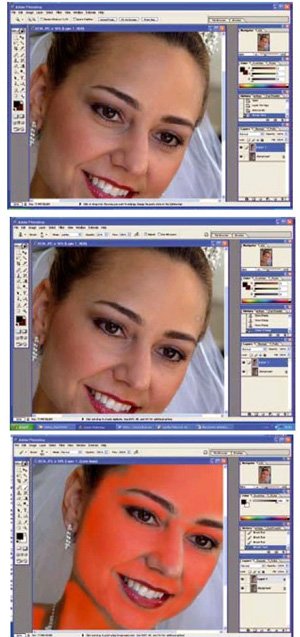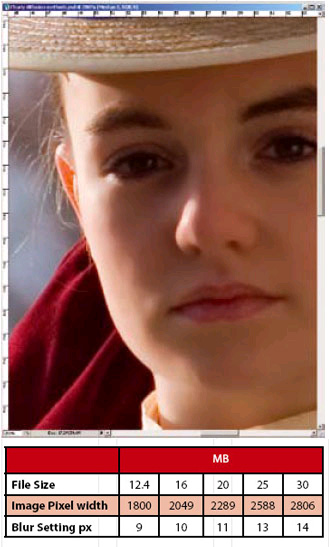articles/Postproduction/softskintexture-page2
Soft on Skin Texture - soft on the causes of skin texture! - part 2 of 1 2 3
by Mike McNamee Published 01/01/2006

Where should you be doing it?
Skin roughness may be real or perhaps an artefact of digital imaging (eg over-emphasis of grain in a scan or use of a high ISO value). If it is real, skin texture will show most prominently in the area that Jane Connerziser calls the diffused highlights. This is the zone between the specular highlights and the shaded areas. In a portrait the zone might provide a good source-area for cloning texture onto an over-bright highlight. Conversely, if the model has poor skin, this is the area where it will show up most prominently and will require the greatest amount of work.
If the poor texture is the result of digital noise (for example) it will be widespread but may be less acceptable on people's faces. Cloning from good areas will not help here and you may have to resort to channel modifications such as blurring the a and b channels in Lab mode or going after a noisy channel, such as the blue channel, from a digital camera.
The Blur Initiatives - contributed by Dave Simm
Whenever you look at portrait entries in American photographic competitions and, indeed the window displays of some of the US's most notable portraitists, the images all have one thing in common, the level of retouching by labs and photographers is almost bordering on plastic surgery.
The subject's flesh looks as smooth as porcelain, nicer than a new born baby's; the eyes are almost like glass, they're so bright and artificial looking - the thing that surprises me the most is just how much the buyers rave about these makeover retouching jobs.

I have never really liked retouching very much, not because I can't do it, - it is more because the finished image just doesn't look like the subject at the end of the day. Having said that, let me share a funny story with you. Some years ago I had an elderly, lady client, who was starting on a second career, selling property. Of course, in America all realtors have to have their pictures on a business card. So I shot a sitting of this old dear and came up with some extremely nice images. After delivering the previews, I received a telephone call from the lady, letting me know how disappointed she was with the pictures; her main complaint was that they didn't look like her.
I was shocked, the portraits were quite beautiful and at this stage, completely unretouched, after all they were just proofs, which I hastened to explain while asking her to call in at the studio to point out her concerns. To help you get a visual impression, I would say she had been a sun worshiper as a younger woman, which meant, in later years, her complexion closely resembled a flesh-coloured prune.
Needless to say a superb retouching job made her look something akin to Marilyn Monroe; I was certain that this would delight her. With a deadpan face the woman exclaimed that this portrait was not the least bit like her. I could see what she meant but for totally different reasons. Then she pointed to her teeth and said they're crooked, well yes they were, ever so slightly, but enough for her to be hyperconscious of it. Ok - back to the digital file and a quick cut-twist and paste just to see the beaming smile on this ever so wrinkled physiognomy..."Now that looks just like me," she jubilantly proclaimed.
So now, all my effort was worthy of printing out as a 1" x 1.5" to illuminate her business card...and before you ask, Yes - I lost money on it because all around Chicagoland, studio business portraits are sold as packages deals...sitting, six previews, retouching and a finished print, all for a fixed price. It had, however, become a point of honour, of course, it really didn't do me any harm to please a realtor, after all there are over 30,000 of them in greater Chicago, I wouldn't want any adverse customer relations knocking about a potential client base of that size.
So where is all this going? Well as I said, I am just not crazy about over retouching, but if you intend to enter American print competitions you had better have a working knowledge, or at least an arrangement with a good competition lab in this country. Above all, there will be occasions like the scenario I just described, where a client, so desperately in need of plastic surgery, needs you to come to the rescue.
There is, however, one discipline of portraiture that could actually use these techniques on a daily basis and that is the Hollywood Style Glamour Portrait. I selected this tight head-shot of a bride to illustrate this feature for two reasons, the image is large enough for you to observe the changes, and working on the PPF rule (lots of pixels per face) it is very easy to make a good looking, large format print, which is the stock in trade of the glamour studio.
Please Note:
There is more than one page for this Article.
You are currently on page 2
- Soft on Skin Texture - soft on the causes of skin texture! page 1
- Soft on Skin Texture - soft on the causes of skin texture! page 2
- Soft on Skin Texture - soft on the causes of skin texture! page 3
1st Published 01/01/2006
last update 09/12/2022 14:59:06
More Postproduction Articles
There are 0 days to get ready for The Society of Photographers Convention and Trade Show at The Novotel London West, Hammersmith ...
which starts on Wednesday 15th January 2025





